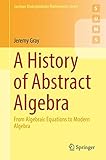A History of Abstract Algebra [electronic resource] : from Algebraic Equations to Modern Algebra / Jeremy Gray.
Material type: TextSeries: Publication details: Cham, Switzerland : Springer, c2018.Description: 1 online resourceISBN:
TextSeries: Publication details: Cham, Switzerland : Springer, c2018.Description: 1 online resourceISBN: - 978-3-319-94773-0
- 1615-2085
| Item type | Current library | Call number | Status | Date due | Barcode | |
|---|---|---|---|---|---|---|
| E-Resources | Balanga Library E-Resources | 510 (Browse shelf(Opens below)) | Available | EBC00809 |
Includes bibliographical references and index.
Introduction -- 1 Simple quadratic forms -- 2 Fermat's Last Theorem -- 3 Lagrange's theory of quadratic forms -- 4 Gauss's Disquisitiones Arithmeticae -- 5 Cyclotomy -- 6 Two of Gauss's proofs of quadratic reciprocity -- 7 Dirichlet's Lectures -- 8 Is the quintic unsolvable? -- 9 The unsolvability of the quintic -- 10 Galois's theory -- 11 After Galois -- Introduction -- 12 Revision and first assignment -- 13 Jordan's Traité -- 14 Jordan and Klein -- 15 What is 'Galois theory'? -- 16 Algebraic number theory: cyclotomy -- 17 Dedekind's first theory of ideals -- 18 Dedekind's later theory of ideals -- 19 Quadratic forms and ideals -- 20 Kronecker's algebraic number theory -- 21 Revision and second assignment -- 22 Algebra at the end of the 19th century -- 23 The concept of an abstract field -- 24 Ideal theory -- 25 Invariant theory -- 26 Hilbert's Zahlbericht -- 27 The rise of modern algebra -- group theory -- 28 Emmy Noether -- 29 From Weber to van der Waerden -- 30 Revision and final assignment -- A Polynomial equations in the 18th Century -- B Gauss and composition of forms -- C Gauss on quadratic reciprocity -- D From Jordan's Traité -- E Klein's Erlanger Programm -- F From Dedekind's 11th supplement -- G Subgroups of S4 and S5 -- H Curves -- I Resultants -- Bibliography -- Index.
This textbook provides an accessible account of the history of abstract algebra, tracing a range of topics in modern algebra and number theory back to their modest presence in the seventeenth and eighteenth centuries, and exploring the impact of ideas on the development of the subject. Beginning with Gauss's theory of numbers and Galois's ideas, the book progresses to Dedekind and Kronecker, Jordan and Klein, Steinitz, Hilbert, and Emmy Noether. Approaching mathematical topics from a historical perspective, the author explores quadratic forms, quadratic reciprocity, Fermat's Last Theorem, cyclotomy, quintic equations, Galois theory, commutative rings, abstract fields, ideal theory, invariant theory, and group theory. Readers will learn what Galois accomplished, how difficult the proofs of his theorems were, and how important Camille Jordan and Felix Klein were in the eventual acceptance of Galois's approach to the solution of equations. The book also describes the relationship between Kummer's ideal numbers and Dedekind's ideals, and discusses why Dedekind felt his solution to the divisor problem was better than Kummer's. Designed for a course in the history of modern algebra, this book is aimed at undergraduate students with an introductory background in algebra but will also appeal to researchers with a general interest in the topic. With exercises at the end of each chapter and appendices providing material difficult to find elsewhere, this book is self-contained and therefore suitable for self-study.--
There are no comments on this title.

